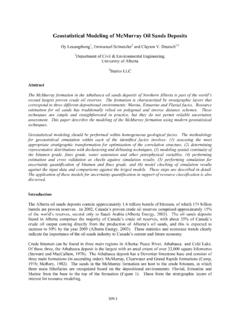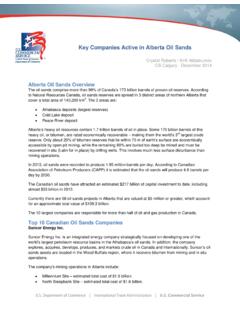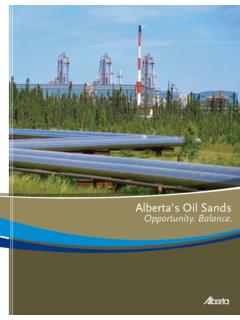Transcription of OSCA FIFO PositionPaper Final Word
1 Position PaperFIFO in the Oil Sands: Fly-In/Fly-Out Operations in the RMWBS ubmitted to: Oil Sands Community Alliance (OSCA)January 2018 Table of Contents 1. Executive Summary .. 1 2. Background and Purpose .. 3 3. Current State of FIFO .. 6 4. Rationale Behind FIFO .. 11 5. Investment by industry .. 17 6. Local Economic Impacts .. 19 7. Other Considerations .. 20 Participating Companies Suncor Syncrude CNRL Imperial Oil ConocoPhillips Devon Cenovus Nexen Jacos Connacher A Position Paper on FIFO The Oil Sands Community Alliance 11. Executive Summary Purpose of this Paper There is considerable discussion and debate in the Wood Buffalo region regarding the use of fly-in/fly-out (FIFO)-based operations.
2 With the increased use of FIFO, especially in relation to ongoing operations, the municipality and others in the community are expressing concerns of potential effects from FIFO, including taking jobs away from locals and limiting the region s potential growth. In response, the Oil Sands Community Alliance (OSCA) has developed a discussion paper regarding the oil sands industry s use of FIFO. The objectives of this position statement are to: better inform local and provincial government, communities, businesses and service providers about the rationale and operational considerations related to the use of this strategy, and contribute to ongoing discussions regarding industry s motivation, the potential to attract FIFO workers to live in the region and the possibility of enhancing the regional benefits of FIFO.
3 Current Use of FIFO There are currently 15 projects in the region which are identified as FIFO-based operations. Eleven of these projects utilize seven private aerodromes, while four projects use the Fort McMurray International Airport (YMM). Other projects use YMM and private aerodromes to move workers on an as-needed basis. These FIFO-based projects represent approximately 60% of the province s total annual oil sands production, while employing less than half the existing oil sands operations workforce in the region. FIFO-Based Projects are Predominantly in Remote Locations Most of the FIFO-based projects in the region are remote, located an average of 110 km from Fort McMurray. The northern projects are an average of 100 km from the edge of Fort McMurray, while the southern projects are an average of 120 km.
4 Drive times to these projects are correspondingly long. Including the time for neighbourhood pickup and drop off routes and from the project gate to work areas, one-way trips range from a minimum of one and one-half hours to over three hours. This does not factor in morning and evening peak traffic, lower speed limits on industrial roads, and weather conditions. While a few smaller projects are in proximity to Fort McMurray, the majority of FIFO-based projects are essentially located outside of a safe daily commuting distance for shift workers. In industry s experience, a FIFO-based system is the only viable approach for these projects. A Key Driver for FIFO is Reducing Traffic and Improving Safety on Area Highways Traffic reduction and driving safety were and remain key motivators behind FIFO programs, a priority of both the residents in the region as well as companies and workers.
5 A Position Paper on FIFO The Oil Sands Community Alliance 2 industry has Invested Substantially in FIFO Infrastructure FIFO programs were contemplated and constructed in a period of high economic activity and population growth. industry has invested hundreds of millions in infrastructure to support FIFO, justified by years of planned future operational use. On-Site or Nearby Private Aerodromes Save Time and Money The economics of FIFO varies and is influenced by a number of cost considerations. Considering worker time, operational requirements and overall human resource management, including the cost of employee relocations, FIFO programs are cost-effective. Historically and up to today, flying directly to and from site has been the most efficient way for remote projects to move personnel, reduce costs and travel time and increases the quality of life for workers.
6 FIFO Programs Also Benefit YMM In addition to private aerodrome activity, substantial FIFO-related activity utilizes the Fort McMurray International Airport. According to the Airport Authority, an estimated 45% of travelers indicated they were a part of the FIFO worker population. FIFO-related activity also contributes tens of millions in annual expenditures in local contracts and income for employees in the region. The Trend towards FIFO is Not Unique to the Region The increase in FIFO-based operations is not unique to oil sands development in the RMWB. It aligns with broader trends observed in resource development in Canada and beyond, driven by several factors including workforce competition and societal preferences.
7 Companies Remain Committed to Supporting Local Workers and Communities From industry s perspective, FIFO is not an either-or decision. Companies remain committed to hiring locally and developing the regional labour force, while also using workers from outside the region to effectively staff operations. industry strives to ensure benefits related to FIFO activities as well as broader operations accrue to the region. Although remote, these projects cumulatively spend roughly $1billion annually on contractors, suppliers and employees in the region. Further, inclusion of Fort Chipewyan in FIFO programs contributes to the hamlet s ongoing sustainability and helps residents to maintain their traditional ways of life.
8 A Position Paper on FIFO The Oil Sands Community Alliance 32. Background and Purpose Background One of the logistical challenges faced by oil sands developers is how to effectively transport large numbers of workers to and from worksites in the region. At first, this was largely accomplished by contracted bussing from Fort McMurray with only limited use of FIFO arrangements. The earliest FIFO-type program was operated by Syncrude since the 1980s involving Fort Chipewyan. However, as oil sands development moved farther away from Fort McMurray, and as local residents became increasingly concerned with the socio-economic impacts of out-of-region workers on their communities, the use of FIFO to support camp-based operations became increasingly common.
9 So much so that today there are roughly 15 oil sands operations in the region that use FIFO to transport the majority of their operations-related workers. These 15 projects represent roughly 60% of total oil sands production capacity in the province. The use of FIFO arrangements is of interest to government, host communities, and industry . Specifically: Municipalities have expressed an interest in seeing more workers relocate to the region. There is a perception that FIFO is an impediment because it makes it easier for workers to live elsewhere, and as a result, fewer workers, their spouses and families are living in the region and contributing towards community well-being. Local business communities which, although benefit from existing FIFO-related spending ( materials, supplies), would like to see more workers live in the region.
10 There is a feeling that the use of FIFO means missed opportunities to gain additional population in the region and the associated household spending. There is a perception that economic activity is effectively bypassing, or flying over , the region via the private aerodromes. Local workers, including those in Indigenous communities, are interested in obtaining employment at oil sands projects. Again, a perception exists that FIFO-based operations facilitate jobs being filled by workers from outside the region, thereby making it more difficult for local residents to take advantage of existing employment and business opportunities. industry , which has to attract highly qualified workers, minimize operating costs and staff projects outside of daily commutable distance.












